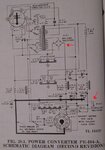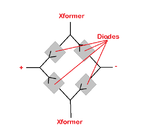Grey Wulf
Newbie level 3
Hello guys, I am new here. I need some help with an old WWII radio power converter, PE-104. Can anyone help me design a replacement to the selenium recs in the picture below. Red arrows show the power rec and ballast rec. What diode would be best? Input power is either 6 or 12 volt. Output voltage is 1.5 on the recs. The 84 and 51 volts are rectified by a syncronous vibrator.



